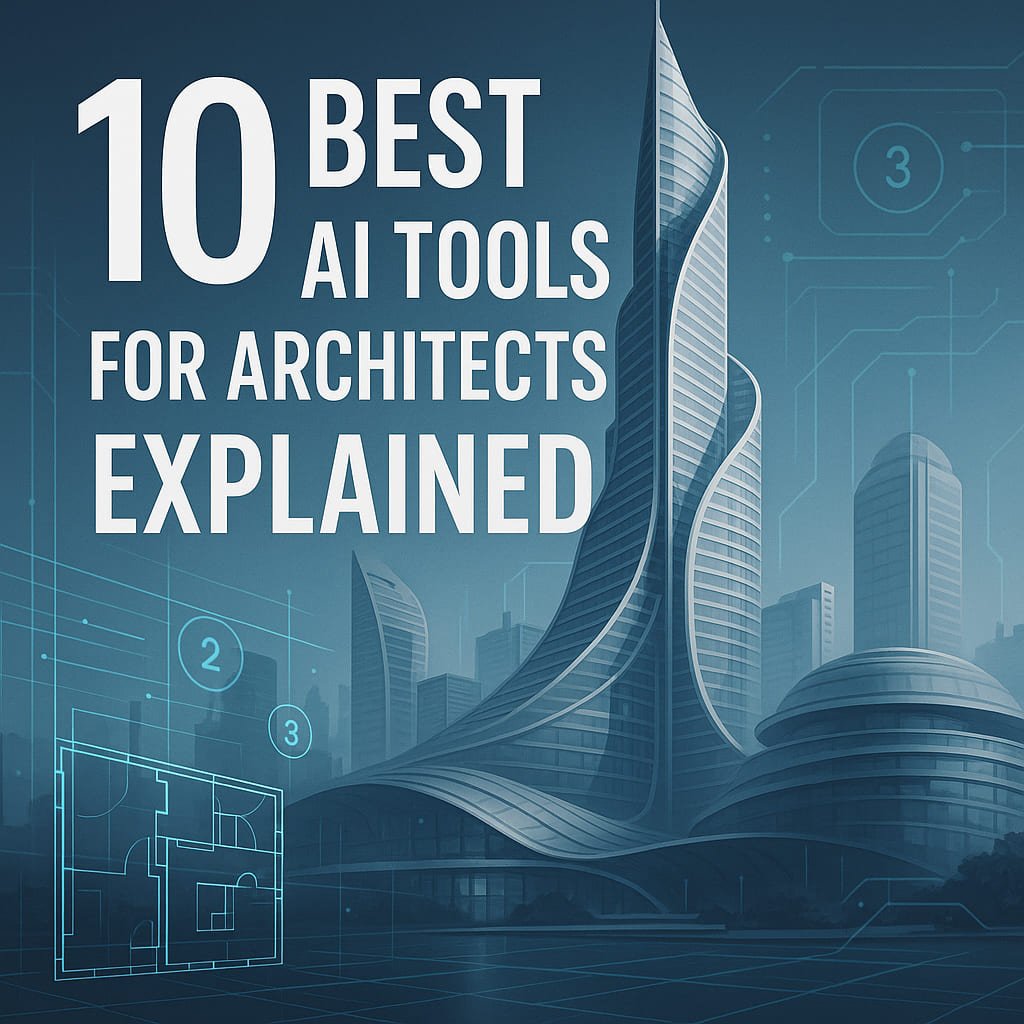Transforming Blueprints into Brilliance: AI for the Modern Architect
Picture this: It’s 2 AM, and you’re still tweaking a client presentation because the lighting in your 3D render looks just slightly off—AI Tools for Architects could’ve saved you hours. Sound familiar? Architects juggle endless deadlines, evolving designs, and clients who want to “see the vision” before the first brick is laid. Enter AI tools—your new secret weapon. From automating tedious tasks to generating jaw-dropping visuals in minutes, AI is reshaping how architects work. In this guide, we’ll explore the top 10 AI tools that’ll save you time, boost creativity, and impress even the pickiest clients.
Comparison Table: AI Tools for Architects at a Glance
| Tool | Key Features | Pricing (Starting) |
|---|---|---|
| Autodesk Revit | Parametric design, BIM integration | $335/month |
| SketchUp + AI | Plugins for quick modeling | $119/year |
| ArchiCAD | Collaborative BIM, VR walkthroughs | $220/month |
| Blender | Open-source 3D modeling, AI rendering | Free |
| V-Ray | Photorealistic rendering | $470/year |
| Lumion | Real-time visualization | $1,499/year |
| MidJourney | AI concept art generation | $10/month |
| DALL-E 3 | Text-to-3D ideation | $20/month |
| Enscape | Live rendering, VR support | $39/month |
| TestFit | AI-powered space planning | Custom quote |
10 Best AI Tools for Architects Explained
1. Autodesk Revit
What It Does:
Revit is the gold standard for Building Information Modeling (BIM), letting you create detailed 3D models with embedded data (like material specs or costs). Its AI-powered features automate tasks like clash detection (e.g., spotting plumbing conflicts in walls) and generating schedules.
Key Features:
- Parametric Components: Change one element (like a window size), and the entire model updates automatically.
- Cloud Collaboration: Teams work simultaneously on shared models, with version control.
- AI Analytics: Predicts energy efficiency or structural stress points.
Why Architects Love It:
Perfect for skyscrapers or hospitals where precision matters. The learning curve is steep, but once mastered, it’s unmatched for complex projects.
Use Case: Designing a sustainable office tower where HVAC systems need to sync with architectural plans.
2. SketchUp + AI Plugins
What It Does:
SketchUp’s intuitive interface is supercharged by AI plugins like Veras (text-to-3D) or AI Render (auto-texturing). Turn rough sketches into polished models or generate landscaping ideas in seconds.
Key Features:
- Quick Concept Generation: Type “modern cabin with glass facade” and get a 3D draft.
- Style Transfer: Apply textures from reference images (e.g., “make this concrete look weathered”).
- Layout Optimization: AI suggests furniture arrangements based on room dimensions.
Why Architects Love It:
Ideal for freelancers who need to iterate fast. The base tool is affordable, but AI plugins add costs.
Use Case: Rapidly prototyping a client’s vague “rustic-meets-futuristic” home idea.
3. ArchiCAD
What It Does:
A Revit alternative with a stronger focus on team collaboration and VR presentations. Its AI tools automate repetitive tasks like generating elevation views or tagging materials.
Key Features:
- BIMcloud: Securely share models with contractors and clients.
- AI-Driven Documentation: Auto-generates floor plans and sections.
- VR Walkthroughs: Clients explore designs in immersive 3D using Meta Quest headsets.
Why Architects Love It:
Simplifies teamwork for mid-sized firms. Less customizable than Revit but more user-friendly.
Use Case: Presenting a mixed-use development to stakeholders with interactive VR tours.
4. Blender
What It Does:
This free, open-source tool is a powerhouse for organic shapes and AI-aided rendering. Use add-ons like Stable Diffusion to turn rough models into polished visuals via text prompts.
Key Features:
- AI Rendering (Cycles X): Faster, noise-free renders using machine learning.
- Geometry Nodes: Procedural modeling for intricate designs (e.g., parametric facades).
- Community Plugins: Free AI tools for terrain generation or material synthesis.
Why Architects Love It:
Zero cost, endless flexibility. Requires coding skills for advanced AI features.
Use Case: Crafting a sculptural pavilion with AI-generated fractal patterns.
5. V-Ray
What It Does:
A rendering engine that uses AI to create hyper-realistic visuals. Its AI Denoiser cleans up grainy renders in seconds, and Scene Intelligence auto-adjusts lighting.
Key Features:
- Material Library: AI suggests realistic textures based on your design style.
- GPU Acceleration: Renders complex scenes 10x faster.
- 360° Panoramas: Clients “walk through” spaces on their phones.
Why Architects Love It:
Makes even placeholder models look stunning. Integrates with Revit and SketchUp.
Use Case: Marketing a luxury resort with sunset-lit pool renders that seal the deal.
6. Lumion
What It Does:
Turn models into cinematic visuals in real time. Drag-and-drop trees, people, and weather effects. AI auto-adjusts shadows and reflections as you move the camera.
Key Features:
- LiveSync: Syncs with SketchUp/Revit—changes in the model update instantly in Lumion.
- Mass Placement: AI scatters thousands of plants or furniture pieces naturally.
- Mood Filters: Apply “Golden Hour” or “Moody Urban” presets with one click.
Why Architects Love It:
No rendering expertise needed. Perfect for last-minute client requests.
Use Case: Revamping a presentation overnight after a client says, “Can we see it in winter?”
7. MidJourney
What It Does:
Generate concept art from text prompts. While not a CAD tool, it’s genius for brainstorming unconventional shapes or materials (e.g., “a library shaped like a swirling galaxy”).
Key Features:
- Style Blending: Merge references (e.g., “Zaha Hadid + Art Deco”).
- Variation Modes: Get four design options per prompt.
- Upscaling: Refine rough ideas into high-res images for mood boards.
Why Architects Love It:
Breaks creative blocks. Outputs aren’t technical but spark client excitement.
Use Case: Pitching a futuristic cultural center with AI-generated “wow” factor.
8. DALL-E 3
What It Does:
Create 3D-adjacent concepts from text. Unlike MidJourney, it’s better at spatial depth. Ask for “a transparent bridge with floating gardens” and get a multi-angle visual.
Key Features:
- Contextual Understanding: Interprets complex prompts accurately.
- Edit Mode: Refine specific parts of an image (e.g., “make the roof curved”).
- ChatGPT Integration: Refine ideas through conversational AI.
Why Architects Love It:
Great for abstract or experimental projects. Not for precise modeling.
Use Case: Visualizing a client’s vague “organic, eco-friendly retreat” concept.
9. Enscape
What It Does:
Live-render models as you work. Clients see changes in real time during meetings. AI optimizes textures and lighting on the fly.
Key Features:
- One-Click VR: Convert models into VR experiences instantly.
- Asset Library: AI suggests context-appropriate decor (e.g., modern vs. rustic).
- Collaboration Annotations: Clients mark up renders directly in the tool.
Why Architects Love It:
Eliminates “waiting for renders” delays. Syncs with Revit, SketchUp, and Rhino.
Use Case: Live-editing a kitchen layout while the client watches on Zoom.
10. TestFit
What It Does:
AI-powered site planning that maximizes space and profitability. Input lot dimensions, zoning rules, and budget—it generates optimal building footprints.
Key Features:
- Feasibility Studies: Tests 100+ layout options in minutes.
- Cost Estimation: Auto-calculates construction costs per square foot.
- Parking Optimization: AI arranges stalls to meet codes with minimal wasted space.
Why Architects Love It:
Turns days of manual tweaking into a 10-minute task.
Use Case: Designing a high-density apartment complex with AI-optimized unit layouts.
How to Choose Right AI Tools for Architects
Ask yourself:
- Budget: Can you afford a $1,500/year tool, or is free/open-source better?
- Skill Level: Are you ready for Revit’s complexity, or do you need SketchUp’s simplicity?
- Project Type: Large-scale BIM (Revit/ArchiCAD) vs. quick renders (Lumion/Enscape).
- Collaboration Needs: Cloud-based tools (Revit) vs. standalone (Blender).
Pro Tips for Maximizing AI Tools for Architects
- Combine Tools: Use MidJourney for concepts + Revit for precision.
- Automate Repetition: Let TestFit handle site plans while you focus on design.
- Learn Shortcuts: Most tools have hidden AI features (e.g., V-Ray’s AI denoiser).
- Stay Updated: AI evolves fast—subscribe to newsletters like ArchTech Today.
Ethical Considerations
- Transparency: Tell clients if AI generated their concept art.
- Bias: Ensure AI doesn’t recycle outdated design tropes.
- Data Privacy: Avoid tools that claim ownership of your models.
The Future of AI Tools for Architects
Imagine AI that:
- Generates carbon-neutral designs automatically.
- Predicts construction challenges via VR simulations.
- Turns client feedback into real-time model adjustments.
Conclusion on AI Tools for Architects
AI won’t replace architects—it’ll make you unstoppable. Whether you’re a solo freelancer or part of a firm, there’s a tool here to cut your workload and amplify creativity. Start with one tool that solves your biggest pain point (hello, 2 AM render fixes!), and build from there.
Check Out: AI Tools for Sustainable Agriculture
FAQs for AI Tools for Architects
Q: Will AI replace architects?
A: No—it’s a tool to enhance your work, not a replacement for human ingenuity.
Q: Are there free AI tools for students?
A: Yes! Blender and DALL-E’s free tier are great starting points.
Q: How long does it take to learn these tools?
A: Some (like Lumion) take days; others (like Revit) require months. Start small!
Q: Can AI handle complex zoning laws?
A: Not yet—always double-check with legal experts.
Follow 10 Best AI Tools on LinkedIn for more






